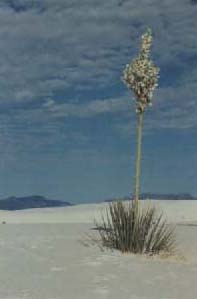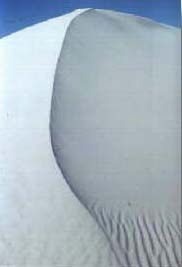White Sands

National Monument
 At the northern end of the Chihuahuan Desert lies a mountain-ringed valley known as the Tularosa Basin. Rising from the heart of this basin is one of the world's great natural wonders, New Mexico's White Sands. Great Sahara-like dunes of gypsum sand cover 300 square miles of the desert.
At the northern end of the Chihuahuan Desert lies a mountain-ringed valley known as the Tularosa Basin. Rising from the heart of this basin is one of the world's great natural wonders, New Mexico's White Sands. Great Sahara-like dunes of gypsum sand cover 300 square miles of the desert.
 The Tularosa Basin is a closed basin, meaning that the valley has no outlet to the Rio Grande River. All water that flows into the basin from rain and snow fall, either percolates into the soil or accumulates in the shallow, seasonal lakes. The largest of these seasonal lakes is Lake Lucero.
The Tularosa Basin is a closed basin, meaning that the valley has no outlet to the Rio Grande River. All water that flows into the basin from rain and snow fall, either percolates into the soil or accumulates in the shallow, seasonal lakes. The largest of these seasonal lakes is Lake Lucero.
The sedimentary rocks in the adjacent Andreas Mountains are rich in gypsum which is an evaporite mineral that is highly soluble in water. As rain/snow runoff contacts these rocks, the gypsum is dissolved and carried to the basin floor. A large amount of runoff accumulates in Lake Lucero during wet seasons. As the water evaporates, the gypsum previously dissolved in the water begins to precipitate in the shallow lake bed. Each season more gypsum accumulates as more water evaporates. Then, during dry, windy seasons, the gypsum grains are blown out of the lake bed and accumulate in the giant dune fields of the White Sands National Monument.
The White Sands National Monument is a unique geological environment due to the fact that the sand dunes are composed of gypsum grains. Most sand dunes are composed of quartz grains.
 The Monument offers Full-Moon Tours in the summer months. Each summer month, during the night of the full moon, the Monument presents a special viewing opportunity. Visitors are treated to the amazing effects of moonlight on the brilliant white, gypsum sand. An amazing experience.
The Monument offers Full-Moon Tours in the summer months. Each summer month, during the night of the full moon, the Monument presents a special viewing opportunity. Visitors are treated to the amazing effects of moonlight on the brilliant white, gypsum sand. An amazing experience.
The White Sands Visitor Center is open daily from Memorial Day through Labor Day 8AM to 7PM with extended hours for the Full Moon Tours. During the fall, winter, and spring, the Visitor Center is open 8AM to 5PM. Call (575)-479-6124 for more information.
All images are Copyright 1995 Mary Saxton.
any reproduction of images must leave images
unaltered and give full credit to Mary Saxton.





















